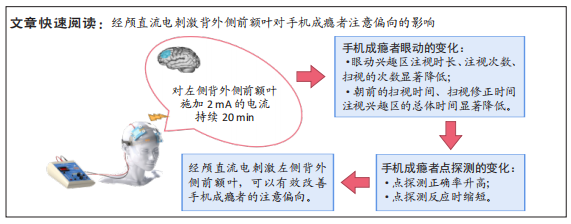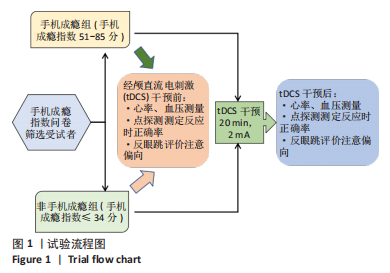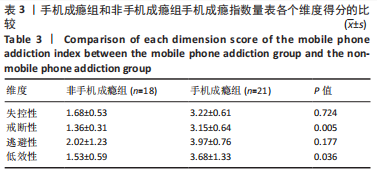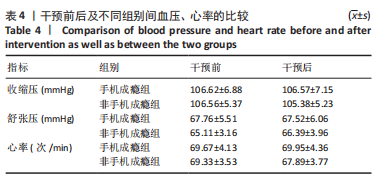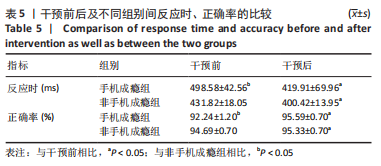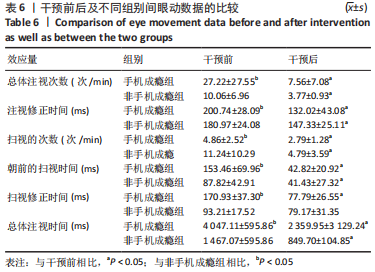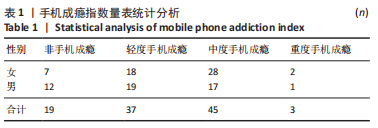[1] 朱有为, 赵敏. 药物依赖所致认知偏向及其研究进展[J]. 中华精神科杂志,2017,50(4):260-263.
[2] 程帅. 智能手机依赖者对其依赖源相关线索的注意偏向研究[D]. 杭州:浙江师范大学,2019.
[3] FIELD M, COX WM. Attentional bias in addictive behaviors: a review of its development, causes, and consequences. Drug Alcohol Depend. 2008;97(1-2):1-20.
[4] 郝晨蕊, 李小青, 高宜. 心理虐待与忽视对青少年手机依赖的影响:依恋与述情障碍的中介作用[C].proceedings of the 第二十届全国心理学学术会议--心理学与国民心理健康摘要集, F, 2017.
[5] KNIGHT HC, SMITH DT, ELLISON A. The role of the left dorsolateral prefrontal cortex in attentional bias. Neuropsychologia. 2020;148: 107631.
[6] LUIGJES J, SEGRAVE R, DE JOODE N, et al. Efficacy of invasive and non-invasive brain modulation interventions for addiction. Neuropsychol Rev. 2019;29(1):116-138.
[7] SANTOS FERREIRA I, TEIXEIRA COSTA B, LIMA RAMOS C, et al. Searching for the optimal tDCS target for motor rehabilitation. J Neuroeng Rehabil. 2019;16(1): 1-12.
[8] SIMONETTI D, ZOLLO L, MILIGHETTI S, et al. Literature review on the effects of tDCS coupled with robotic therapy in post stroke upper limb rehabilitation. Front Hum Neurosci. 2017;11:268.
[9] HALKO M, DATTA A, PLOW EB, et al. Neuroplastic changes following rehabilitative training correlate with regional electrical field induced with tDCS. Neuroimage. 2011;57(3):885-891.
[10] RODELLA C, CESPÓN J, REPETTO C, et al. Customized application of tDCS in clinical rehabilitation of Alzheimer’s Disease. Frontiers in Human Neuroscience. 2021;15:422.
[11] LUO YP, LIU Z, WANG C, et al. Anodal transcranial direct current stimulation alleviates cognitive impairment in an APP/PS1 model of Alzheimer’s disease in the preclinical stage. Neural Regen Res. 2022; 17(10):2278-2285.
[12] WU LL, POTENZA MN, ZHOU N, et al. Efficacy of single-session transcranial direct current stimulation on addiction-related inhibitory control and craving: a randomized trial in males with Internet gaming disorder. Journal of Psychiatry and Neuroscience, 2021;46(1):E111-E118.
[13] SEELEY WW, CRAWFORD RK, ZHOU J, et al. Neurodegenerative diseases target large-scale human brain networks. Neuron. 2009;62(1):42-52.
[14] FREDRICKSON BL, COHN MA, COFFEY KA, et al. Open hearts build lives: positive emotions, induced through loving-kindness meditation, build consequential personal resources. J Pers Soc Psychol. 2008;95(5):1045.
[15] BOGGIO PS, ZAGHI S, VILLANI AB, et al. Modulation of risk-taking in marijuana users by transcranial direct current stimulation (tDCS) of the dorsolateral prefrontal cortex (DLPFC). Drug Alcohol Depend. 2010;112(3):220-225.
[16] NAKAMURA‐PALACIOS EM, SOUZA RS, ZAGO‐GOMES MP, et al. Gray matter volume in left rostral middle frontal and left cerebellar cortices predicts frontal executive performance in alcoholic subjects. Alcoholism. 2014;38(4):1126-1133.
[17] VOLKOW ND, KOOB GF, MCLELLAN AT. Neurobiologic advances from the brain disease model of addiction. New Eng J Med. 2016;374(4): 363-371.
[18] LEUNG L. Linking psychological attributes to addiction and improper use of the mobile phone among adolescents in Hong Kong. J Child Media. 2008;2(2):93-113.
[19] NITSCHE MA, BOGGIO PS, FREGNI F, et al. Treatment of depression with transcranial direct current stimulation (tDCS): a review. Exp Neurol. 2009;219(1):14-19.
[20] KONDO H, OSAKA N, OSAKA M. Cooperation of the anterior cingulate cortex and dorsolateral prefrontal cortex for attention shifting. Neuroimage. 2004;23(2):670-679.
[21] ORTUNO F, OJEDA N, ARBIZU J, et al. Sustained attention in a counting task: normal performance and functional neuroanatomy. Neuroimage. 2002;17(1):411-420.
[22] YOSHIDA W, FUNAKOSHI H, ISHII S. Hierarchical rule switching in prefrontal cortex. Neuroimage. 2010;50(1):314-322.
[23] VANDERHASSELT MA, DE RAEDT R, BAEKEN C, et al. The influence of rTMS over the left dorsolateral prefrontal cortex on Stroop task performance. Exp Brain Res. 2006;169(2):279-282.
[24] GAZZALEY A, RISSMAN J, D’ESPOSITO M. Functional connectivity during working memory maintenance. Cogn Affect Behav Neurosci. 2004;4(4):580-599.
[25] HOPPENBROUWERS SS, DE JESUS DR, STIRPE T, et al. Inhibitory deficits in the dorsolateral prefrontal cortex in psychopathic offenders. Cortex. 2013;49(5):1377-1385.
[26] LAVEY R, SHERMAN T, MUESER KT, et al. The effects of yoga on mood in psychiatric inpatients. Psychiatr Rehabil J. 2005;28(4):399-402.
[27] BROWNING M, HOLMES EA, MURPHY SE, et al. Lateral prefrontal cortex mediates the cognitive modification of attentional bias. Biol Psychiatry. 2010;67(10):919-925.
[28] CISLER J M, KOSTER E H. Mechanisms of attentional biases towards threat in anxiety disorders: An integrative review. Clin Psychol Rev. 2010;30(2):203-216.
[29] CLARKE P J, BROWNING M, HAMMOND G, et al. The causal role of the dorsolateral prefrontal cortex in the modification of attentional bias: evidence from transcranial direct current stimulation. Biol Psychiatry. 2014;76(12):946-952.
[30] DUBUSON M, KORNREICH C, VANDERHASSELT M-A, et al. Transcranial direct current stimulation combined with alcohol cue inhibitory control training reduces the risk of early alcohol relapse: A randomized placebo-controlled clinical trial. Brain Stimulation. 2021;14(6):1531-1543.
[31] SHAHBABAIE A, GOLESORKHI M, ZAMANIAN B, et al. State dependent effect of transcranial direct current stimulation (tDCS) on methamphetamine craving. Int J Neuropsychopharmacol. 2014; 17(10):1591-1598.
[32] SHAHBABAIE A, HATAMI J, FARHOUDIAN A, et al. Optimizing electrode montages of transcranial direct current stimulation for attentional bias modification in early abstinent methamphetamine users. Front Pharmacol. 2018;9:907.
[33] CLARKE PJ, VAN BOCKSTAELE B, MARINOVIC W, et al. The effects of left DLPFC tDCS on emotion regulation, biased attention, and emotional reactivity to negative content. Cogn Affect Behav Neurosci. 2020;20(6):1323-1335.
[34] IRONSIDE M, O’SHEA J, COWEN PJ, et al. Frontal cortex stimulation reduces vigilance to threat: implications for the treatment of depression and anxiety. Biol Psychiatry. 2016;79(10):823-830.
[35] YANG SN, MCCONKIE GW. Eye movements during reading: A theory of saccade initiation times. Vision Res. 2001;41(25-26):3567-3585.
[36] DJAMASBI S, SIEGEL M, TULLIS T. Generation Y, web design, and eye tracking. Int J Human Computer Studies. 2010;68(5):307-323.
[37] NELSON JM, PHILLIPS CA, MCKINLEY RA, et al. The effects of transcranial direct current stimulation (tDCS) on multitasking performance and oculometrics. Military Psychol. 2019;31(3):212-226.
[38] FILMER HL, MATTINGLEY JB, DUX PE. Improved multitasking following prefrontal tDCS. Cortex. 2013;49(10):2845-2852.
|
